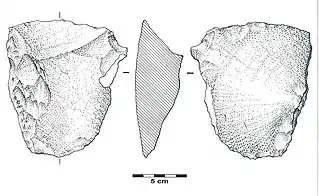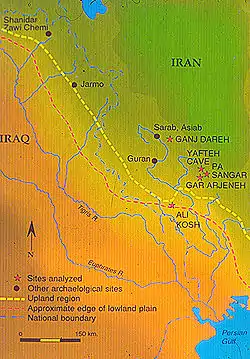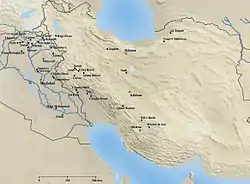Prehistory of Iran
The prehistory of the Iranian plateau, and the wider region now known as Greater Iran, as part of the prehistory of the Near East is conventionally divided into the Paleolithic, Epipaleolithic, Neolithic, Chalcolithic, Bronze Age and Iron Age periods, spanning the time from the first settlement by archaic humans about a million years ago until the beginning historical record during Neo-Assyrian Empire, in the 8th century BC.
Part of a series on the |
|---|
| History of Iran |
 |
|
Timeline |
Paleolithic
_Amar_Merdeg%252C_Mehran%252C_Ilam%252C_Lower_Paleolithic%252C_National_Museum_of_Iran.jpg.webp)
One of the potential routes for early human migrations toward southern and eastern Asia is Iran, a country characterized by a wide range of geographic variation and resources, which could support early groups of hominins who wandered into the region. Evidence for the presence of these early populations in Iran includes some stone artifacts discovered from gravel deposits along the Kashafrud River Basin in eastern Iran, the Mashkid and Ladiz Rivers in the southeast, the Sefidrud River in the north, the Mahabad River in the northwest, and some surface occurrences and isolated finds from the west and northwestern parts of the country.

The main known early human occupation sites in Iran are: Kashafrud in Khorasan, Mashkid and Ladiz in Sistan, Shiwatoo in Kurdistan, Ganj Par in Gilan, Darband Cave in Gilan, Khaleseh in Zanjan, Tepe Gakia (34°13′N 47°13′E) 14 km (8.7 mi) due east of Kermanshah,[1] Pal Barik in Ilam. These sites fall between one million years ago to 200,000 years ago.

Mousterian Stone tools made by Neanderthal man have also been found in various parts of the country.There are more cultural remains of Neanderthal man dating back to the Middle Paleolithic period, which mainly have been found in the Zagros region and fewer in central Iran at sites such as Kobeh, Kaldar, Bisetun, Qaleh Bozi, Tamtama, Warwasi. In 1949 a Neanderthal radius was discovered by CS Coon in Bisitun Cave.[2]
Evidence for Upper Paleolithic and Epipaleolithic periods are known mainly from the Zagros region in the caves of Kermanshah and Khoramabad such as Yafteh Cave and a few number of sites in the Alborz range and Central Iran. In October 2018 a tooth belonging to a Neanderthal child has been discovered in Iran for the first time. The tooth belongs to a six-year-old child that was found along with some rocky tools of the middle Paleolithic period in the mountains of Kermanshah province.[3]
Epipaleolithic
The end of the Palaeolithic, called Epipalaeolithic, is in a period of about 7000 years from c. 18,000 to 11,000 BC. In those days groups of hunter-gatherers were mostly living in the caves of the Zagros Mountains. Compared to earlier groups of game hunters, a tendency towards increasing the number of the kinds of plants and animals, which were collected and hunted, can be observed. Not only smaller vertebrates were hunted but also pistachios and wild fruit were collected. Finally, consuming snails and smaller aquatic animals like crabs is new (Flannery 1973).

Neolithic to Chalcolithic
Almost nothing is known about the 2500 years which followed the Epipalaeolithic after 11,000 BC. Only when discovering the place of Asiab (c. 8500-8000) in the Kermanshah area are we in better known periods. Asiab was a small camp of hunter-gatherers, only seasonally inhabited. Besides the fact that wild goats and sheep were hunted, great numbers of snail shells were found. These finds were interpreted in the way that from time to time the hunting activities of the inhabitants of Asiab were unsuccessful and that then they were forced to consume food which they usually did not like.
_Tappeh_Sarab%252C_Kermanshah_ca._7000-6100_BCE_Neolithic_period%252C_National_Museum_of_Iran.jpg.webp)
Some nearby and more constantly occupied settlements in the Zagros date from a short time after Asiab, from the time between 8,000 and 6,800 BC. Still the material culture of Tappeh Ganj Dareh and Tappeh Abdul Hosein does not include any pottery. Thus this period is often called “aceramic Neolithic”. This is also true for the oldest levels of Tappeh Guran, located in Luristan, as well as for the sites of Ali Kosh and Chogha Sefid in the plain of Deh Luran, west of the Zagros Mountains. There, flocks of sheep and herds of goats were kept for the first time. Managing animals meant a fundamentally new orientation of the Neolithic inhabitants of Iran and must be understood to be connected with a whole number of other innovations, particularly the architecture of houses. We do not definitely know if in those days there was any cultivation of cereals. Tools for harvesting and for making cereal products are there, but remnants of burned grain are extremely rare.


In the eighth millennium BC, agricultural communities such as Chogha Bonut (the earliest village in Susiana)[4] started to form in western Iran, either as a result of indigenous development or of outside influences. Around about the same time the earliest known clay vessels and modeled human and animal terracotta figurines were produced at Ganj Dareh and Teppe Sarab, also in western Iran.[5][6] The south-western part of Iran was part of the Fertile Crescent. Some of the oldest agricultural ground has been discovered in Susa (now a city still existing since 7000 BC).[7][8] and settlements such as Chogha Mish, dating back to 6800 BC;[9][10] there are 7,000-year-old jars of wine excavated in the Zagros Mountains[11] (now on display at The University of Pennsylvania) and ruins of 7,000-year-old settlements such as Sialk are further testament to that.
Early agricultural communities such as Chogha Golan in 10,000 BC[12][13] along with settlements such as Chogha Bonut (the earliest village in Elam) in 8000 BC,[14][15] began to flourish in and around the Zagros Mountains region in western Iran.[5] Around about the same time, the earliest-known clay vessels and modeled human and animal terracotta figurines were produced at Ganj Dareh, also in western Iran.[5] There are also 10,000-year-old human and animal figurines from Tepe Sarab in Kermanshah Province among many other ancient artifacts.[6]
The south-western part of Iran was part of the Fertile Crescent where most of humanity's first major crops were grown, in villages such as Susa (where a settlement was first founded possibly as early as 4395 cal BC)[16] and settlements such as Chogha Mish, dating back to 6800 BC;[9][17] there are 7,000-year-old jars of wine excavated in the Zagros Mountains[18] (now on display at the University of Pennsylvania) and ruins of 7000-year-old settlements such as Tepe Sialk are further testament to that.
Bronze Age

Parts of what is modern-day northwestern Iran was part of the Kura–Araxes culture (circa 3400 BC—ca. 2000 BC), that stretched up into the neighboring regions of the Caucasus and Anatolia.[19][20]
Susa is one of the oldest-known settlements of Iran and the world. Based on C14 dating, the time of foundation of the city is as early as 4395 BC,[21] a time that goes beyond the age of civilization in Mesopotamia. The general perception among archeologists is that Susa was an extension of the Sumerian city state of Uruk.[22][23] In its later history, Susa became the capital of Elam, which emerged as a state found 4000 BC.[21] There are also dozens of prehistoric sites across the Iranian plateau pointing to the existence of ancient cultures and urban settlements in the fourth millennium BC,[9] One of the earliest civilizations in Iranian plateau was the Jiroft culture in southeastern Iran in the province of Kerman.
It is one of the most artifact-rich archaeological sites in the Middle East. Archaeological excavations in Jiroft led to the discovery of several objects belonging to the 4th millennium BC.[24] There is a large quantity of objects decorated with highly distinctive engravings of animals, mythological figures, and architectural motifs. The objects and their iconography are unlike anything ever seen before by archeologists. Many are made from chlorite, a gray-green soft stone; others are in copper, bronze, terracotta, and even lapis lazuli. Recent excavations at the sites have produced the world's earliest inscription which pre-dates Mesopotamian inscriptions.[25][26]
There are records of numerous other ancient civilizations on the Iranian Plateau before the emergence of Iranian peoples during the Early Iron Age. The Early Bronze Age saw the rise of urbanization into organized city states and the invention of writing (the Uruk period) in the Near East. While Bronze Age Elam made use of writing from an early time, the Proto-Elamite script remains undeciphered, and records from Sumer pertaining to Elam are scarce.
Russian historian Igor M. Diakonoff states that the modern inhabitants of the Iranian Plateau are descendants of mainly non-Persian groups: "It is the autochthones of the Iranian plateau, and not the Proto-Indo-European tribes of Europe, which are, in the main, the ancestors, in the physical sense of the word, of the present-day Iranians."[27]
Early Iron Age

Records become more tangible with the rise of the Neo-Assyrian Empire and its records of incursions from the Iranian plateau. As early as the 20th century BC, tribes came to the Iranian Plateau from the Pontic–Caspian steppe. The arrival of Iranians on the Iranian plateau forced the Elamites to relinquish one area of their empire after another and to take refuge in Elam, Khuzestan and the nearby area, which only then became coterminous with Elam.[28] Bahman Firuzmandi say that the southern Iranians might be intermixed with the Elamite peoples living in the plateau.[29] By the mid-first millennium BC, Medes, Persians, and Parthians populated the Iranian plateau. Until the rise of the Medes, they all remained under Assyrian domination, like the rest of the Near East. In the first half of the first millennium BC, parts of what is now Iranian Azerbaijan were incorporated into Urartu.

See also
References
- Freeman, Leslie G., ed. (1978). Views of the Past: Essays in Old World Prehistory and Paleanthropology. Mouton de Gruyter. p. 15. ISBN 978-3111769974. Retrieved 31 October 2017.
- Trinkaus, E & Biglari, F. (2006). "Middle Paleolithic Human Remains from Bisitun Cave, Iran". Paleorient. 32 (2): 105–111. doi:10.3406/paleo.2006.5192.
- https://ifpnews.com/exclusive/first-neanderthal-human-tooth-discovered-in-iran/
- EXCAVATIONS AT CHOGHA BONUT: THE EARLIEST VILLAGE IN SUSIANA, IRAN Archived 2013-07-25 at the Wayback Machine, by Abbas Alizadeh – The Oriental Institute and the Department of Near Eastern Languages and Civilizations The University of Chicago
- "Iran, 8000–2000 BC". The Timeline of Art History. The Metropolitan Museum of Art. October 2000. Retrieved 2008-08-09.
- retrieved PERSIA the ANCIENT IRAN . ANCIENT IRAN MUSEUM
- Iranian official urges approval of Susa demarcation. payvand.com. 2 September 2008
- Ancient Near Eastern art by Dominique Collon
- Xinhua, "New evidence: modern civilization began in Iran", xinhuanet.com, 10 August 2007
- Hirst, K. Kris Chogha Mish (Iran) Archived 2013-11-06 at the Wayback Machine. archaeology.about.com
- Research. museum.upenn.edu
- "Early humans in Iran were growing wheat 12,000 years ago". NBC.news. July 5, 2013.
- Riehl, Simone. "Emergence of Agriculture in the Foothills of the Zagros Mountains of Iran (Supplement)". www.researchgate.net. Retrieved 1 March 2015.
- "Excavations at Chogha Bonut: The earliest village in Susiana". Oi.uchicago.edu. Archived from the original on 25 July 2013. Retrieved 21 June 2013.
- Hole, Frank (20 July 2004). "NEOLITHIC AGE IN IRAN". Encyclopedia Iranica. Encyclopaedia Iranica Foundation. Archived from the original on 23 October 2012. Retrieved 9 August 2012.
- The Archaeology of Elam: Formation and Transformation of an Ancient Iranian State – by D. T. Potts, Cambridge University Press, 1999-07-29 – page 46–47 – ISBN 0521563585 hardback
- K. Kris Hirst. "Chogha Mish (Iran)". Archived from the original on 2013-11-06. Retrieved 2012-08-23.
- "Penn Museum – University of Pennsylvania Museum of Archaeology and Anthropology". Archived from the original on 2008-12-16.
- Kushnareva, K. Kh. (1997). The Southern Caucasus in Prehistory: Stages of Cultural and Socioeconomic Development from the Eighth to the Second Millennium B.C. UPenn Museum of Archaeology. ISBN 978-0-924171-50-5., page 44
- Sagona, Antonio; Zimansky, Paul (24 February 2015). Ancient Turkey. Routledge. ISBN 978-1-134-44027-6., page 163
- The Archaeology of Elam: Formation and Transformation of an Ancient Iranian State – by D. T. Potts, Cambridge University Press, 29/07/1999 – pp. 45–46 – ISBN 0521563585 hardback
- Algaze, Guillermo. 2005. The Uruk World System: The Dynamics of Expansion of Early Mesopotamian Civilization
- http://oi.uchicago.edu/pdf/saoc63.pdf
- "5000-Y-Old Inscribed Tablets Discovered in Jiroft". Archived from the original on 2011-05-11.
- Cultural Heritage news agency Archived 2008-04-11 at the Wayback Machine retrieved 27 March 2008
- Yarshater, Yarshater. "Iranian history". Encyclopædia Iranica. Retrieved 2008-06-23.
- Diakonoff, I., M., "Media", Cambridge History of Iran, II, Cambridge, 1985, p.43 [within the pp.36–148]. This paper is cited in the Journal of Eurasian Studies at page 51.
- Lackenbacher, Sylvie. "Elam". Encyclopædia Iranica. Retrieved 2008-06-23.
- ^ Bahman Firuzmandi "Mad, Hakhamanishi, Ashkani, Sasani" pp. 20
Further reading
- Bernbeck, R. (2004) Iran in the Neolithic, in T. Stöllner, R. Slotta and A. Vatandoust (eds) Persiens. Antike Pracht. Bochum: Bochum Museum, 140–147
- Biglari, F. and S. Shidrang, 2006 "The Lower Paleolithic Occupation of Iran", Near Eastern Archaeology 69 (3–4): 160–168
- Smith, P. E. L. (1986) – Paleolithic archaeology In Iran, Philadelphia (PA): University Museum, University of Pennsylvania.